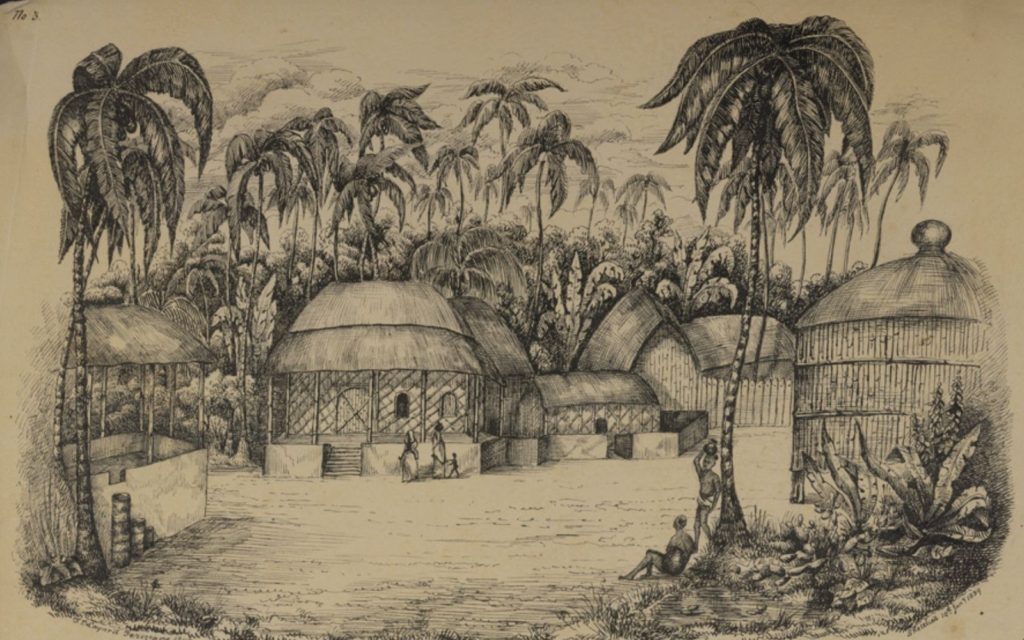River deltas comprise just one percent of global landscape but support over half a billion people. As you can see from the satellite imagery below, the Bay of Bengal delta is an amorphous space-an admixture of land and water, a cultural ecotone that transcends the political boundaries of India and Bangladesh. In recent years the littoral region has come to be recognised as ‘the ground zero of climate change’. While deltas are nowadays considered important food baskets that have increasingly become vulnerable to food insecurity and environmental degradation, they have also remained largely marginal to national imagination and have been neglected within the discipline of area studies. With increasing threats from global warning and sea level rise, deltas must now take centre-stage in understanding the ‘grand challenges’ of our time before it is too late.
Before the universalisation of the term Sundarbans (etymologically meaning ‘beautiful forest’), the part land and part water landscape were referred to in the literature of the Middle Ages as the land of eighteen tides, atharo bhatir desh. This reflected the agency of the watery landscape; and recognized the ‘tides’, ‘ocean’, ‘rivers’ and ‘tributaries’ that shape the history, culture and ecology of the deltas.
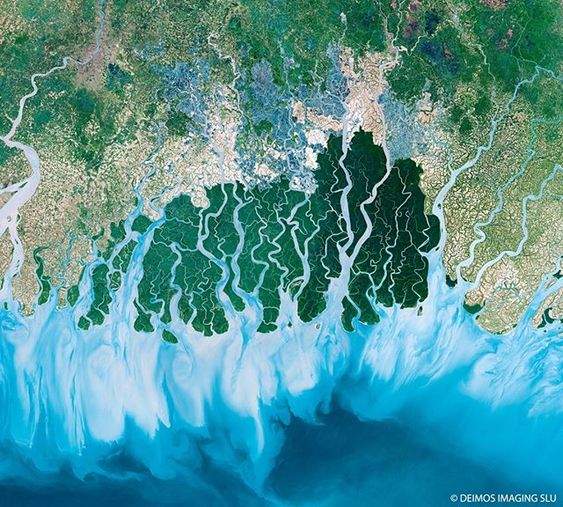
Satellite image of the Sundarbans, world’s largest bird footed delta (photo credit: Deimos imaging SLU)
The delta is one of the most amazing examples of a transient environment where nothing remains permanent. The landmass is constantly on the move – shaped by the fluvial processes of the Ganges, the Brahmaputra and the Padma River. The Sundarbans form the largest bird-footed delta in the world and support a megaphonic ‘ecotone’ composed of the mangrove ecosystem that support biodiversity and shields the islands from tropical storms and deadly cyclones.
Legend has it that the Sundarban delta is a part of the patal lok mentioned in our puranic literature that signifies the underworld -a place of hell teeming with serpents, crocodiles and other more-than-human entities that represent darkness, evil and chaos. From the puranic literature to the contemporary times, the delta has emerged as an excluded exotic space in the popular imagination of Bengal – the sinister mythological representations got reinforced by the colonial characterization of the deltas’ vast saturated landmass as unproductive ‘waste’land to be reclaimed through the building of embankments and the clearing of mangrove forests for human habitation that started in the late 18th century with the passing of Permeant Settlement Act.
This colonial intervention was crucial in the history of the deltas This colonial intervention was the first of its kind and remains crucial in the history of the deltas,- for it imposed on the region, the distinctly western notion of land-based “property-thinking” that ultimately shaped the utilitarian project of imagining the watery landscape as a revenue frontier of Bengal Presidency. This had a significant impact on the local ecology as it also led to the property-based approach of looking at certain kinds of land as unproductive land or “Wasteland”. The ethical framework behind this line of thought came from English utilitarian thinkers like John Lock and John Stewart Mill. In this context the vast mangrove wetlands emerged as “wastelands” in the eyes of colonial administrators who wanted this primarily fluvial geography to be reclaimed for settled agriculture that will fill the coffers of the Bengal Presidency. This kind of unilateral imagination of nature had its own pitfalls as, over time, it exposed the delta environment to severe tropical storms, cyclones and Tsunami as the mangrove forest cover was cleared to create settlements for immigrants and landless peasants.
The Sunderbans : A Cultural Ecotone
The deltas are a part of a biodiversity hotspot- a ‘megafauna’ that connects the region with the wider littoral world. The interconnectedness and coexistence of human communities and cultures produces diverse landscapes, which can well be compared with the diversity of human geography and the notion of the ‘ecotone’ in ecology.
In the recent past, the concept of ‘ecotone’ has found a wide range of application – from the world of environmental studies or landscape geography to a broad space of human geography. For cultural geographers and environmental anthropologists who have promoted the ontological turn in social theory since the 1990s, the emphasis on elements andspecies beyond the human presents the cosmopolitan understanding of the relationship between nature and culture.
According to Mark Sutton and E.N. Anderson, ‘cultural ecotone’ is a contact zone where the cultural space of two different communities of human beings with diverse socio-ecological realities meet and merge. In the context of Sundarbans, it is represented in subsistence agriculture-based economies of peasants that has merged with fisherfolk and forest gores which in turn comprise a variety of caste groups. This is a zone of intercultural encounter where the seeds of transculturality have been incubated and grown, over several historical periods. The Sundarban deltas present a ‘cultural ecotone’ where the confluence of different tribes, races, communities and belief systems has produced a hybrid social space reflected in people’s everyday practices such as the worship of Bonbibi, the lady of the forest, who belongs to the vernacular liturgical tradition of the region and symbolises the unity between the Hindu and Muslim pantheon in the island. The works of stalwart historians like Richard Eaton (1993) and Nile Green (2008) offer exciting possibilities for deconstructing the old paradigm of Islam as a monolithic ‘World Religion’ and Hinduism as a Sanskrit-ised Indological tradition. The Bengal delta with its unique geography and ‘ecotonic’ transition has historically played the role of a corridor to nurture an exciting space for transregional diffusion of cultures and beliefs that have produced ‘hybrids’. Here hard borders/ boundaries are absent and do not define social identity. Rather identities are co-produced by the liminal nature of these shifting landscapes that are malleable and ever changing with the turning tides, cyclones, floods, and the migration of people across the Indian Ocean world.
Reading The Sunderbans : The Literature of The Deltas
While the puthi literature presents a genealogical understanding of nature and culture, these records were written and commissioned by the privileged Bengali Brahmins who introduced Dharam worship into the region by adopting local gods into the wider ambit of Hindu fold. Examples of this religious co-opting can be found in the eulogizing of Manasa the goddess of serpents, Sitala the goddess of measles and the battle of Dakhin Rai and Bonbibi who have long been classified as folk deities. This incorporation of local sylvan deities into the religious pantheons of Bengal itself hints at the creation of a hybrid social space within the Sankrit-ised Hindu fold. This transformation occurred primarily in the marshy parts of the Sundarbans deltas now in Bangladesh, beyond the Rhar bhumi (the eastern part of Bengal, east of Ganges River).
While anthropologists have classified the local beliefs into a two-tier system with ‘little’ and ‘great’ traditions, I find this classification challenging because there are various versions of Ramayan and Mahabhara retold by local scholars, scribe writers and narrated by local scroll artists- patachitrakars and doggerel poem singers. Rather, the diffusion between great epics and the ‘little’ local traditions is what expresses the liminal religiosity and syncretic religious practices of the Sundarbans delta. For example, Pika Ghosh (2003, pp 387) in her work Unrolling a scroll narrative, observes that the ‘goddess Durga plays a prominent role in the Bengali version of the Ramayan on behalf of Rama in his battle with Ravana’. In Bengal, which had no “authentic” classical tradition of its own, folk culture came to be seen not merely as the archetypal Other but also as the source of a reconstituted tradition that the region could hold up as an exemplar for India as a whole. Beginning with its roots in the ideology of romantic nationalism, folklore has thus seen much reordering in contemporary India.

Bahadur chitrakar – scroll painter of Medinipur (Naya Pingla village) reciting Ramayana with Durga as protagonist (Proto credit Dr. Anindita Kundu Saha).
The puthi literature of the Sundarban deltas thus provides a diachronic understanding of the social and political ecology of the region. In this article, I will try to argue why conservation efforts and community work in the region need to go hand in hand – it is important, while caring for the environment in the deltas to understand not only the bio physical ecotone of the region but also the social and cultural hybridity of the place. The foundation of my ontology stands on two premises- 1). The ‘ethics of care’ for non-human subjects and the morality of controlling self-indulgence highlighted in puthi literature and, 2). The growing debate within deep ecological thinking about ecological egalinitarism and biocentrism, a move that distinctly shifts away from the earlier positivist and post-enlightenment anthropocentrism. These concepts are crucial towards understanding human care for the non-human. The human and non-human aspects of nature cannot be seen as the competing ecologies that modern scientific shallow ecological discourse would have usbelieve. The puthi literature, for example, Bonobibi Jawaharnama and Manasa Mangal attend to the concepts of biocentrism and ecological egalinitarism where humans are seen as part of nature and not as dominant or superior agents.
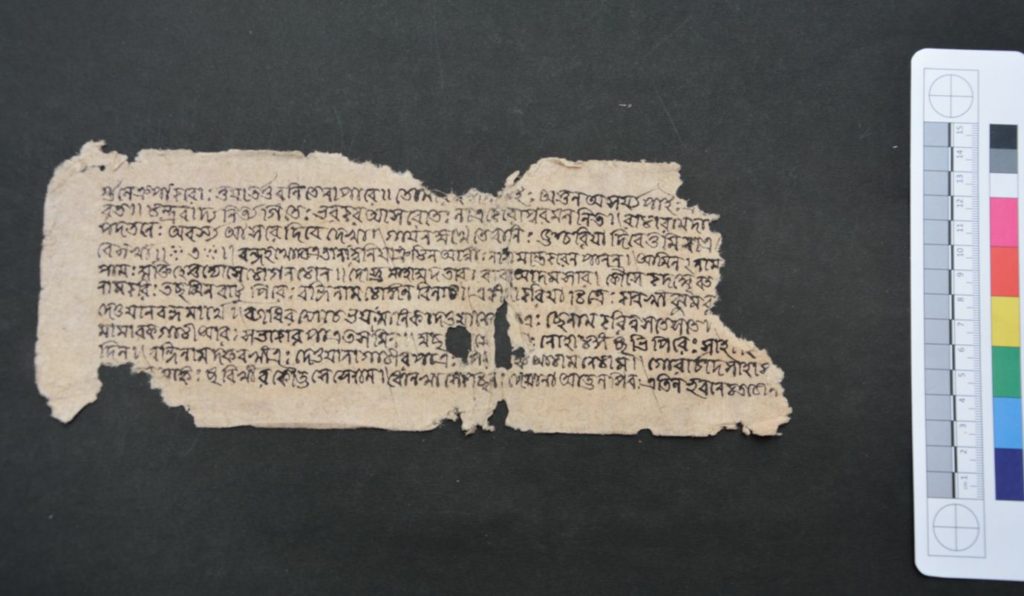
Folio of Satya Pirer Panchali, 19th Century, Sundarban Ancholik Sangraysala Collection. BL EAP 759 collection.

The Importance of Land over Water in an Amphibious Ecotone
Notably, much of this research on Sundarbans’ literature has been essentially on terra firma: the obsession with permanence and stable land still remains unquestioned when talking about hybridity. Such an unchallenged acceptance of land-based physical environment as the essence of landscape assemblages contradicts the fluidity inherent in the conceptualisation of hybridity. More importantly, it undermines the postcolonial origins of the idea of hybridity and its association with anti-essentialism as proposed by Bhabha and Nandy (see Bhabha, 1994; Nandy, 1983). In other words, the invocation of socio-natural might risk the conceptualization of hybridity in precisely absolute terms, leaning instead, upon the amalgamation of two or more elements. This is true of the Sundarbans delta where the Puthi literature has been appropriated by Bengali scribe writers and proponents of Dharma Sanskritised literature during the Middle Ages to support popular aspiration of the society as well as elevate localised belief system to the mainstream pantheon of Hinduism. The one-dimensional classification of ‘little’ and ‘great’ traditions as autonomous belief practices proposed in the ethnographies of McKim Marriot and Milton Singer through their studies among small communities in India during the 1960-70 established a rupture in the study of complex Indian society influenced by orientalist-Indological thinking and Sanskritization which was not very popular in Bengals littoral environment where people still wrote in vernacular Bengali and were embedded in popular cultural practices. The great epics of Hinduism such as Ramayan and Mahabharat also find regional variations in the text and multiple meanings are drawn out of these epics in the local context by scroll painters- patachitrakars of Bengal. As historian Jawahar Sarkar notes, “the valorising of the popular deities of the ‘depressed’ masses of the region would, in effect, permit or facilitate the Brahman’s entry into this hitherto-abjured realm of ‘low’ local worships. Both the two acts of adjustment, popular deities of the antyajas within the Hindu pantheon and of the ‘new agriculturists’ who rose largely from among these forsaken castes that were either within or on the periphery of the Hindu fold”.
“Though Dharma, Manasa, Chandi and the peasant-Shiva of Bengal were the main folk deities that thus entered the general Hindu’s pantheon in western Bengal, thanks chiefly to this genre of balladic poems, even lesser goddesses like Annada, Kalika, Sitala and Shasthi, as well as minor male divinities such as Dakshin Ray and Panchananda, also received homage through their respective Mangals.” (Sarkar 2010).
According to Sarkar, “The Mangal Kavyas were in the language of the masses – Bangla – and were undertaken not by Brahman scholars of high standing and repute at the well-maintained ‘seminaries’, but by individual rural poets, most of who were Brahmins — perhaps with no coordination among themselves”.
Likewise, this cultural hybridity is reflected in the contacts that the littoral rim has established with the wider Indian Ocean world across west, middle and southeast Asia from where Islamic influence has penetrated through presentization carried out by pirs– holy saints of the Bengal delta detached from the Mughal empires of central India.
Colonial Property Rights in The Delta: Fashioning Hard Borders/Edges
The colonial period was a watershed in the delta’s history that swept their hybrid landscape under the carpet by promoting a false material consciousness of ‘waste’ developed out of Locke’s ‘natural rights’, by dividing land and water into units of quantifiable objects for economic use. As a consequence, land reclamation gained momentum in the Bengal delta through construction of embankments and dikes that were originally not designed for permanent human habitation. This brought cataclysmic change to the physical landscape of the delta.
According to Rohan D’souza the Cartesian division of land from water was driven by revenue concerns of the Bengal presidency that resulted in control of the river and its flow. The Bengal delta soon became ‘the great environmental laboratory’ (Hill, 1997) to ‘test European theories on the purpose, use, and control of nature in all its manifestations, the annual floods became more disastrous and riverbank erosion increased’ (Lahiri-Dutt, 2008). Both the Permanent Settlement Act 1793 and Bengal Alluvium and Diluvium Act of 1825 established absolute and permanent land rights over a fluid and transforming landscape leading to the creation of artificial hard borders that were contested in the court of law by local owners of the land. Legal jurisdiction of land went hand in hand with engineering and techno-managerial controls imposed by hydraulic experts. In this process the fluid and transient world of the delta’s waterscape became invisible as land became central to colonial capitalist and mercantile expropriation. This notion continues to hold sway in the postcolonial period.
The Forest Frontier in Badabhon
With the extension of power that has come from the western pursuit of modernisation and creation of timber plantation, forests have become the target of exploitation for their natural resources. The term ‘political forest’ (Vandergeest and Peluso, 2015, as cited by Devine & Baca, 2020) captures the notion that today’s forests have been produced through politics. A history of colonial powers, intervention by international organisations, economic values, and politics from complex articulations of power and practice have transformed forests from ‘natural entities’ to “territorial zones” and “state-held territories” (Devine & Baca, 2020) . The “modern forest” is a place where the politics of sustainability can clearly be observed.
Arguably, the greatest contributions have been made by environmental historians who have illuminated the changing relationship between humanity and nature (see Radkau, 2008). Their early work attempted to emphasise the “social construction” of nature, such as forests (see Jeffrey, 1998). From this, studies moved on to what Agrawal and Sivaramakrishnan (2001) describe as “social nature”, where the artificiality of boundaries between arable lands, forests, and pastures are demolished, problematizing the ways in which certain modes of livelihoods are commonly associated with each of these categories. Environmental historians have reminded us that these are primarily applied administrative categories (Whitehead, 2010) marked by significant movements within and between them. They have recognized the unclassifiable mixed cases and the strong interdependence between various modes of livelihood, the radical changes in landscapes over time, and human strategies of land use that defy the simple distinctions (Scott, 2001, vii). Another thread in their work has been intensive questioning of what comprises environmental knowledge, not only critiquing the subjective position of knowledge producers, but also investigating how knowledge is produced, contested, legitimated, and hybridized (Skaria, 1999). In South Asia, environmental scholars have emphasized the interdependence of biophysical and socio-cultural domains and highlighted the importance of considering poor people’s livelihoods as entrenched in local ecology (Gadgil and Guha, 1992; Guha, 1994). The Sundarban deltas have also been part of this treatment.

Khitish Bishals oil painting representing destruction of forest in the Sundarbans.
The archipelago of the Sunderbans are classical examples of lands at the margins; they are elusive and indefinable. By turning them into revenue generating paddy and shrimp farms, we thought we were protecting them as well as ourselves. Embankments and polders increase the force of wave action and lead to greater coastal erosion and rise in salinity level. Building embankments across the Sundarbans to reclaim wetlands in the last one hundred years did not expand the food basket of the Bengal delta, but merely deprived its contiguous farmlands of vital nutrients. Construction of dams and straightening of rivers have been equally disastrous for the lives of fish, animals and the people that rely on them.
According to Professor R. A Gillis, ‘Living an ecotonal existence, islanders are amazingly sensitive and adaptable to the conditions of both land and water. Their relationship to nature is by no means passive. Indeed, they have been shaping their own environments for millennia.’ (Gillis: p158). It is particularly important to understand that island history is a co-construction of humans and nature. Global history has enough lessons to make us wary of reifying political borders, but we must also be prepared to treat our so-called natural boundaries as equally liquid. Land and water constitute an ecological continuum. We need to be wary of distinguishing the marine too sharply from the terrestrial.
Until quite recently, deltas have been regarded as marginal. Island communities have been of secondary interest to historians and geographers. But now we are beginning to appreciate the centrality of the marginal. Take the delta mangroves, for example. For most of the twentieth century, thousands of kilometres of mangroves have been destroyed in the name of agricultural modernization and urbanization. But now this ecotonal feature is again being recognized as vital to the health of the fields it borders, and to the maintenance of biodiversity generally, after decades of ploughing right up to the edges of their fields, farmers have begun to become aware of the vulnerability of monocultures, the disappearance not only of plant, but animal and bird species. Lately, farmers are again hedging their fields, creating ecotones between forest and field, streams and pastures to prevent erosion and pollution, thereby protecting their bets against flood and tropical cyclones. It is in this moment of planatary crisis- climate change- that we are rediscovering the need for reimagining evanescent environment such as deltas as culturally and socially relevant.
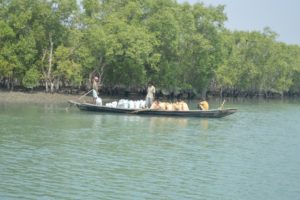
Declining mangrove forest of the Sundarbans Delta: Kumirmari, South 24 Pargana, India
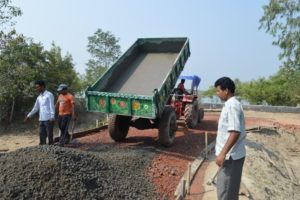
Human activities in the Sundarbans delta: Concrete Road and embankment building programme after Aila cyclone in 2009.

